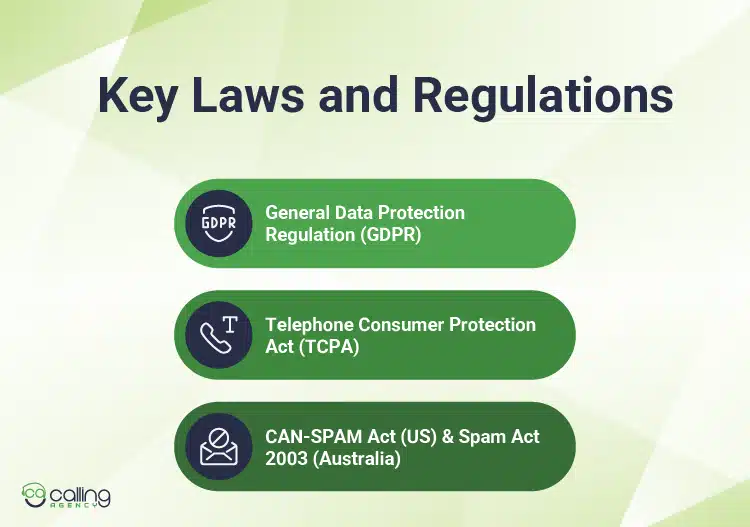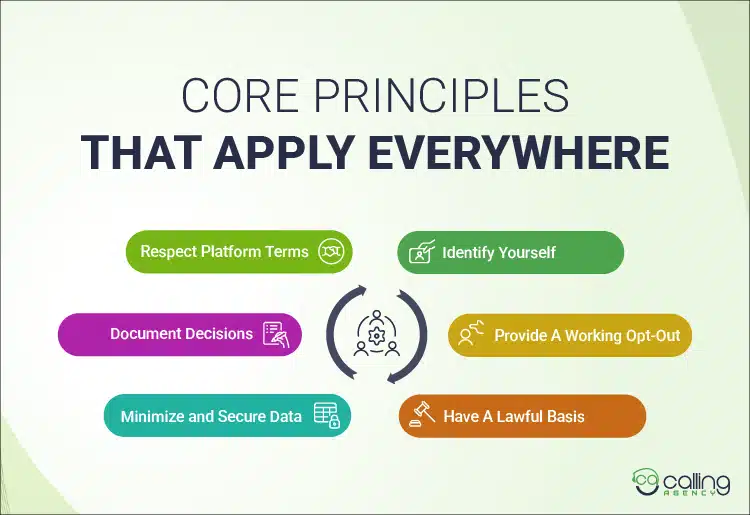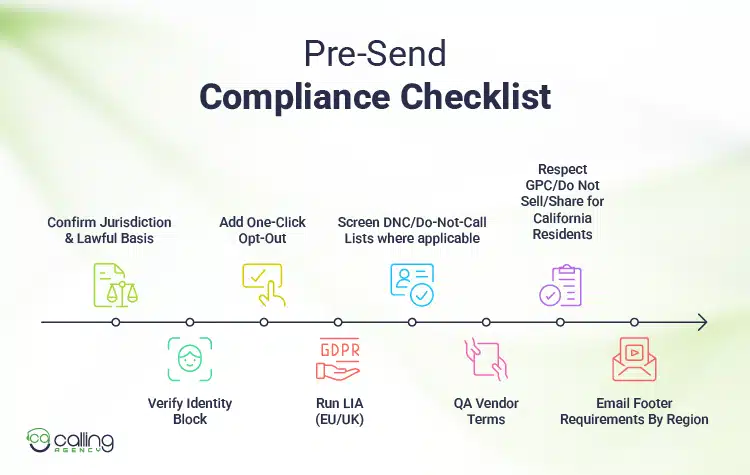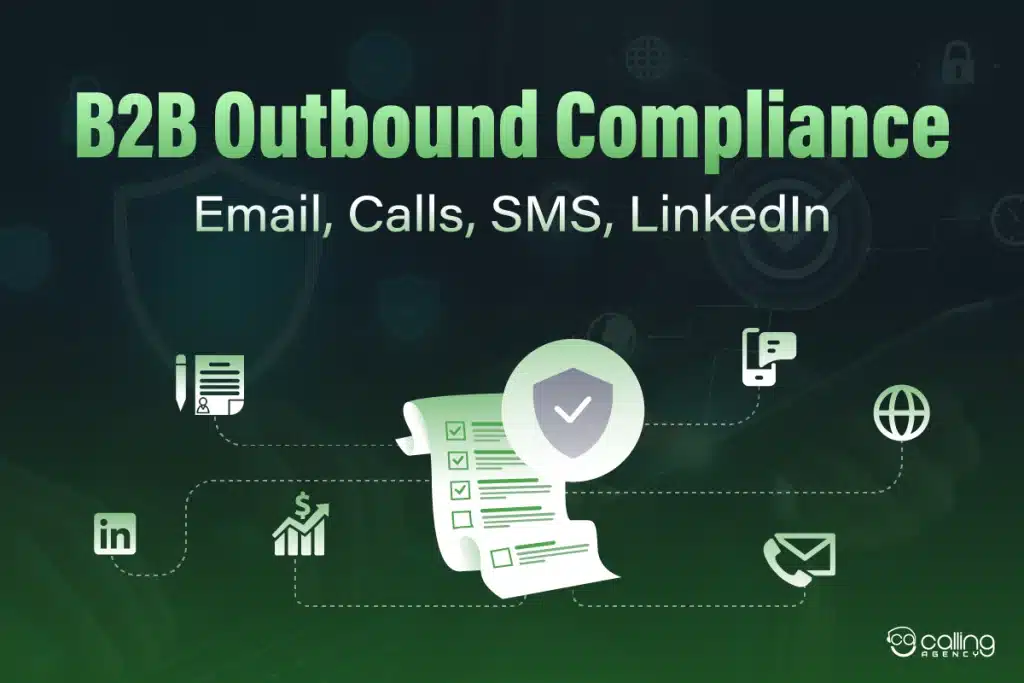Ever wondered why your phone doesn’t explode with business calls, telemarketing transactions, and employee voice comments every other minute? That’s because B2B telemarketing compliance, including terms for outbound calls and potential civil penalties, is a big deal, shaping how businesses and their employees reach out to each other.
It’s a tightrope walk between being persuasive with offers and respecting boundaries in terms of voice and sharing. Following rules and legal guidelines is crucial when doing B2B Outbound Compliance. It’s not about doing the right thing; it is also about keeping trust with the people you are communicating with and avoiding legal problems.
To do this, businesses need to understand and follow anti-spam laws, get proper permission before sending emails, respect privacy and data protection, offer an easy way for peo[ple to opt-out and make sure the sender is clearly identified. By doing all this, companies can run B2B Cold email campaigns in a lawful and responsible way.
Keeping updated on the laws in the places where you do business and where your email recipients are crucial. Laws like the CAN-SPAM Act in the United States and the GDPR in the European Union give guidelines for commercial emails and have specific requirements for businesses to follow.
What is B2B Outbound Compliance?
If you handle any data from your customers, even if it just an email address, you need to have rock-solid data security. And if you do outbound sales of any kind, you need to ensure that your cold outreach is compliant with local cold email laws.
B2B Outbound Compliance means adhering to regulations and ethical practices for contacting prospective businesses and individuals. The rules usually emphasize data privacy, consent and respecting communication preferences.
This practice uses different ways to connect with people, such as phone calls, email, and social media.
Especially when you are setting the B2B appointment with prospects, you should maintain compliance rules. Following the rules will help you can gain your customer’s trust and also create a better and long-lasting relationship with them. you can avoid potential legal problems in the future with the help of these laws and regulations.
Key Laws and Regulations

- General Data Protection Regulation (GDPR): Businesses must obtain permission before using your personal details. They need to clearly explain how the data will be used and respect your privacy preferences.
- Telephone Consumer Protection Act (TCPA): The United States has a law that regulates telemarketing. The law states that companies should back out from making unwanted phone calls to people who are not interested or have unsubscribed.
- CAN-SPAM Act (US) & Spam Act 2003 (Australia): These laws require businesses to obtain permission before sending emails. They also need to make it easy for people to stop receiving emails if they don’t want them anymore.
Core Compliance Practices
- Obtain Consent
- Respect Data Privacy
- Provide an Opt-Out Mechanism
- Be Transparent
- Personalize Outreach
- Train Your Team
- Manage Data Retention
- Differentiate Personal Vs. Business Data
Compliance in B2B outbound builds trust with prospects by showing respect for their data privacy and preferences. This approach also helps to avoid legal problems and protects against data breaches. Being compliant means using good-quality data that people have agreed to share.
Core Principles That Apply Everywhere
The core principles for B2B outbound compliance highlight the importance of safeguarding data and respecting their privacy. These rules stimulate businesses to comply with the law and establish trust with their contacts.
It is essential to follow the guidelines of data privacy regulations like GDPR. Any data collected should be used only for specific and clearly defined purposes. It has to be maintained in accordance with the principle of purpose limitation.

Identify Yourself
It is a primary proposition to include your name, job title, and contact information when communicating professionally. This demonstrates that you are trustworthy and helps create stronger and lasting relationships. It also follows laws that protect privacy and help you avoid legal problems.
Provide a Working Opt-Out
Opt-Out compliance is a legal framework that gives consumers the right to refuse or decline to have their personal information collected, used or shared by businesses. It requires businesses to offer a clear option for consumers to opt out and withdraw consent at any time.
A standard opt-out example is a banner that informs visitors that cookies are in use, accompanied by a “reject” button for consumers to withdraw consent.
In contrast, opt-in consent requires explicit consent to be withdrawn by default. Consumers need to willingly and clearly state they’re fine with a business processing their information before the business can act.
In general, opt-out compliance requirements apply to all types of personal information that businesses collect. This includes:
- Personally Identifiable Information (PII): Names, phone numbers, addresses and any other information that can be used to identify an individual
- Digital Personal Information: IP addresses, third-party cookies, geolocation data, and more
- Sensitive Personal Information: Health records, financial details, religious beliefs, ethnicity, and sensitive information
- Data Collected on Children: Data collected about minors (under the age of 13) has special considerations, including obtaining parental consent and providing parents with the right to opt out of data collection.
Have a Lawful Basis
For processing of personal data to be lawful, you need to identify specific grounds for the processing. This is referred to as a ‘lawful basis’ for processing, and there are six options that depend on your purpose and the nature of your relationship with the individual.
The six lawful bases are:
- Consent- The individual has given clear permission to process their data for a specific purpose.
- Contract- The processing is significant to fulfill a contract with an individual or to take steps on their request before a contract is formed.
- Legal Obligation – This processing is necessary to comply with the law.
- Vital Interests – This is crucial for protecting someone’s life, for instance, in a medical emergency.
- Public Task- This refers to a task carried out in the public interest or for official purposes by a public authority.
- Legitimate Interests- It is essential for the organization’s legitimate interests, provided these interests are not overridden by the individual’s rights and freedoms.
Minimize and Secure Data
The potential dangers of collecting extensive data include data breaches and identity theft, which can lead to severe financial repercussions for the victims. Organizations must prioritize well-built cybersecurity measures, cohere to data protection regulations, and implement ethical data handling practices such as GDPR and HIPAA.
One of the relatively new concepts is called “data minimization”. This rule obliges businesses to collect only the data that they truly require for the specific purpose. This initiative helps protect customers’ personal details and lowers the risk of data breaches.
Organizations also use a suppression list as a strategic tool to enhance email deliverability. By maintaining an up-to-date suppression list, organizations can prevent the accidental sending of emails to undesirable recipients.
Document Decisions (LIA/DPIA)
Documents outlining decisions for Data Protection Impact Assessments (DPIAs) and Legitimate Interest Assessments (LIAs) are used to identify and mitigate high-risk data processing scenarios.
A DPIA is a structured process endeavored to identify and evaluate potential risks associated with the processing of personal data. It is an important tool for negotiating risk and demonstrating compliance with GDPR. It is required at least in the following cases:
- A systematic and extensive evaluation of the personal aspects of an individual, including profiling
- Processing of sensitive data on a large scale
- Systematic monitoring of public areas on a large scale
For instance,
- A bank screening its customers against a credit reference database
- A hospital about to implement a new health information database with patients’ health data
- A bus operator about to implement on-board cameras to monitor drivers’ and passengers’ behavior.
The key elements of a successful DPIA are:
- Identifying whether a DPIA is required
- Defining the characteristics of the project to enable an assessment of the risks to take place
- Identifying data protection and related risks
- Identifying data protection solutions to eliminate risks
- Signing off on the outcomes of the DPIA
- Integrating data protection solutions into the project
Under the UK and EU General Data Protection Regulation (GDPR), organizations are required to provide a clear and powerful justification for the processing of personal data. This comprises outlining the specific nature of the data being processed and providing a clear context regarding the purpose for which the data is being used.
Step-by-Step Guide to Conducting LIA
- Identify the Legitimate Interest
- Assess the Necessity of Processing
- Conducting the Balancing Test
- Document Your LIA
- Implement Safeguards
- Review and Update the LIA
For Example,
- The lender wants to accurately assess the likelihood that they will get back the money they lend out.
- The benefit is to minimize the risk of bad debts and ensure that the lender makes sustainable lending decisions to achieve a reasonable overall rate of return.
- It is also in the interests of the individual making the application that lenders make responsible lending decisions and do not allow them to become overburdened with debt that they cannot afford.
Respect Platform Terms (LinkedIn)
LinkedIn is committed to keeping its members safe and maintaining a fraud- and abuse-free website. In order to protect the members’ data, LinkedIn’s website does not permit the use of any third-party software, including “crawlers”, bots, browser plug-ins, or browser extensions that scrape, modify the appearance of, or automate activity on LinkedIn’s website.
Understanding the legality of LinkedIn means that you have to respect the rules, conditions and laws outlined by the service provider in their ‘Terms of Service’. It includes prohibitions against harmful activities like malware introduction, hacking, unauthorized data access, infringement of intellectual property or privacy rights and content that is fraudulent, unlawful or harassing.
- Adherence to Use Policies
- Protecting Security and Data
- Upholding Legal and Ethical Standards
- Respecting Intellectual Property
- Honest and Appropriate Conduct
- No Harm to Others
Jurisdiction-Specific Rules
It is imperative to understand the concept of jurisdiction as a misinterpretation of the provisions can lead to an increase in costs and time spent in litigation at the least. Jurisdiction is the legal authority structured at multiple levels, often reflecting the administrative divisions of the country, such as federal, state or local levels.
Rules are easier and less costly to apply; they thus conserve judicial and general legal resources. They are also more predictable in their application, which may facilitate efficient private bargaining in the shadow of the law. These rules are made to state sovereignty, dictating the boundaries of a government’s power and how it is exercised in relation to both its own citizens and those of other nations.
United States
Email (CAN-SPAM): (Federal Trade Commission)
The CAN-SPAM Act is a law that controls how businesses can send commercial emails. It has rules that businesses must follow, gives people the choice to stop receiving these emails, and sets heavy fines for those who break the rules. The Federal Trade Commission (FTC) makes sure these rules are followed.
The law applies to all commercial emails, which means any email mainly meant to sell or promote a product or service. This includes emails that advertise content on websites that sell things. It’s important to note that the law also applies to emails sent between businesses. So, any email, even to past customers to tell them about new products, needs to follow the CAN-SPAM Act.
- Accurate Header Information
- Honest Subject Lines
- Include a Physical Address
- Opt-Out Mechanism
Calls/Text (TCPA + TSR)
The Telephone Consumer Protection Act (TCPA) and the Telemarketing Sales Rules (TSR) modulate unsolicited calls and texts by requiring prior express consent from the consumer before sending marketing communications. Both of these regulations were made to restrain telemarketing abuses and protect consumers from receiving unwanted calls and messages.
The U.S. Telephone Consumer Protection Act (TCPA) is the primary rule in the country about phone communications, including text messages. According to the TCPA and rules from the Federal Communications Commission (FCC), businesses cannot send text messages (like SMS and MMS) to a person’s mobile phone using an automatic dialer unless they have received written permission first. This means businesses cannot send group texts without asking for permission.
The Telemarketing Sales Rule is the other major federal law related to telemarketing. The TSR helps protect people from bad telemarketers. It gives the Federal Trade Commission (FTC) and state attorneys general the power to fight against telemarketing scams. It also gives consumers more privacy and helps them understand which telemarketers are real and which are not.
The TSR primarily focuses on telemarketing conduct and deceptive sales practices, while the TCPA focuses on how telemarketing calls and messages are made, particularly regarding automation and consent.
TSR’s Privacy Prohibitions
- Calling a person whose number is on the National Do Not Call Registry or a person who has asked not to get telemarketing calls from a particular company or charity.
- Misusing a Do Not Call list.
- Denying or interfering with a person’s Do Not Call rights.
- Prerecorded messages to a person without that person’s express consent or written agreement to receive such calls and without providing an automated interactive opt-out mechanism.
- Failing to transmit Caller ID information.
- Using threats, intimidation and profane or obscene language
- Causing any telephone to ring or engaging any person in a telephone conversation repeatedly with the intent to annoy, abuse or harass.
Privacy (CPRA/CCPA in California)
On November 30, 2020, Californians voted to approve Proposition 24, which established the California Privacy Rights Act (CPRA). It enhances and expands the California Consumer Privacy Act (CCPA), California’s existing privacy law, which was enacted.
The CPRA’s timeline over the next three years is complex, with several dates contingent upon specific events. Here are the basics:
- November Certification Date – Secretary of State certifies election results
- November Certification Date + 5 days – Employment and B2B exemptions extended; certain provisions authorizing the CPPA go into effect
- January 1, 2021 – CPRA becomes operative, effectively blocking any subsequent and conflicting privacy legislation
- On or about July 1, 2021 – Rulemaking process commences (or later if it has not yet been six months since CPPA formally notified OAG)
- January 1, 2022 – 12-month lookback period for collected data commences
- July 1, 2022 – Deadline for CPPA to adopt final regulations
- January 1, 2023 – CPRA becomes fully operative; employment and B2B exemptions expire, and those datasets become fully regulated by the CPRA
- July 1, 2023 – CPRA becomes fully enforceable by the CPPA
The CPRA (California Privacy Rights Act) has made it so that rules about protecting the privacy of employees and business-to-business (B2B) information will be in effect until January 1, 2023. This gives the California Legislature two years to come up with new laws about privacy for employees and B2B information.
On August 31, California’s legislature ended its 2022 session without adopting legislation to extend the California Consumer Privacy Act (CCPA) employee and business-to-business (B2B) personal information exemptions. In the absence of a special legislative session, these exemptions have expired on January 1, 2023.
The California Privacy Rights Act (CPRA) is a law that adds new rules to protect the personal information of people living in California. This law makes the rights of California residents stronger and puts stricter rules on businesses about how they use personal information. It also creates a new government agency called the California Privacy Protection Agency (CPPA) to help enforce these privacy rules.
European Union
EU data protection legislation is comprised of the General Data Protection (GDPR), the Law Enforcement Directive (LED) and the Data Protection Regulation for EU Institutions, bodies, offices and agencies (EUDPR).
The planned ePrivacy regulation strengthens data protection and safeguards the privacy of users in the digital world. It complements the General Data Protection Regulation (GDPR) and sets down specific and GDPR-compliant rules for the processing of personal data in electronic communications. It covers various forms of communication such as emails, SMS, telephone calls and VoIP
Legal Basis & ePrivacy Directive (European Data Protection Board) (Usercentrics)
The legal basis of GDPR is a directly applicable EU Regulation which provides a unified data protection framework. And the ePrivacy rules are based on a Directive that requires Member States to implement national laws. It creates some national variations through a single ePrivacy Regulation, aiming to harmonize these rules across the EU.
The GDPR is a law that helps protect people’s personal information. The ePrivacy Regulation, along with its earlier version called the ePrivacy Directive, has specific rules for protecting privacy in electronic communication, like emails and messages. It works alongside the GDPR to ensure privacy is respected.
General Data Protection Regulation (GDPR)
- Purpose– It is a legal framework to protect the personal information of everyone in the EU.
- Scope– It is applicable to any organization that handles personal data in the EU, regardless of its location and physical presence.
- Legal Basis – This is based on Article 8(3) of the Charter of Fundamental Rights of the European Union.
Proposed ePrivacy Regulation
- Purpose- To create simple rules for using electronic communication and technologies like cookies, following the GDPR
- “Lex Specialis” Principle- It creates a specific rule that overrides the general rules of the GDPR in cases of conflict.
- Scope- Makes sure that both the content and information about who sent the messages are kept private in electronic communications.
- Enforcement- Data protection authorities (DPAs) will enforce the GDPR and the ePrivacy Regulation.
United Kingdom
In the United Kingdom, there are rules called the Privacy and Electronic Communications Regulations (PECR) that say that businesses like limited companies, partnerships and some government offices can receive marketing emails without needing to give consent.
However, when it comes to personal information about specific employees in these businesses, the UK General Data Protection Regulation (GDPR) stipulates that companies must ask for permission from those employees before sending them marketing messages.
Canada (CASL)
Canada’s Anti-Spam Legislation is a law intended to protect its citizens from the harmful impacts of spam, unsolicited computer programs and the unauthorized alteration of transmission data by establishing rules for sending commercial electronic messages (CEMs).
Businesses need to get permission from the person receiving their message. There are two ways to get this permission: express and implied consent. The rules also say that the messages must have certain information, like who is sending the message, why they are sending it, and an easy way for the person to unsubscribe or stop receiving messages.
Australia (Spam Act 2003)
The law prohibits sending unsolicited emails or spam using an Australian link. Under the law, an Australian link exists if the email is sent from Australia, was commissioned in the country, or originates from another country but is sent to an Australian address.
Australia’s Spam Act 2003 has three key elements: consent, identifying information and unsubscribe messages. These three pillars are fundamental to ensuring compliance with Australia’s Spam Act and avoiding legal and financial repercussions from the Australian Communications and Media Authority (ACMA).
Singapore (PDPA + DNC Registry)
The Personal Data Protection Act (PDPA) establishes rules for how organizations collect, use and disclose personal data, including a national Do Not Call (DNC) Registry. The Registry allows individuals to opt out of receiving unwanted marketing messages via phone, SMS, fax by registering their numbers for free on the registry.
Whether your organization is directly sending such marketing messages, causing the message to be sent or authorizing another organization to do so, you have to ensure that such messages are not sent to Singapore telephone numbers registered with the DNC Registry.
India (TRAI TCCCPR)
The Telecom Regulatory Authority of India (TRAI) has amended the Telecom Commercial Communications Customer Preference Regulations (TCCCPR) to further strengthen consumer protection against Unsolicited Commercial Communication (UCC). This setup helps everyone involved in the business communication to follow the guidelines to reduce unwanted commercial communications (UCC).
What are the Platform Rules for LinkedIn?
LinkedIn has rules that clearly prohibit people from using automation tools or other programs to access, copy and collect from their website. This is explained in their User Agreement and Terms of Service. The consequences of violating these rules may include account suspensions or bans or Legal Actions.
Operational Checklists
Operational checklists standardize the tasks and procedures within your business, ensuring everyone follows the same steps to complete a task. This standardization leads to consistent service or product quality, reducing errors and increasing efficiency.
Pre-Send Compliance Checklist
A Pre-Send Compliance Checklist helps make sure that the law is being followed and do the right thing is done before sending any messages. This checklist covers important things like protecting people’s personal information, obtaining permission from users, ensuring that the information is correct and preventing any scams.
Confirm Jurisdiction & Lawful Basis
You need to identify which laws apply to your audience and your legal reasons for processing their data. Under GDPR, personal information can be used for six reasons: consent, contract, legal obligation, vital interests, public task, and legitimate interests.
Verify Identity Block
A basic checklist for identity verification to ensure everything is correct includes these steps: getting permission from the user, checking that the documents are real by looking at features like the Machine-Readable Zone (MRZ) and special codes, and using biometrics, such as facial recognition or fingerprint scans, to make sure the person is really there and that their face matches the one on the document.
Add One-Click Opt-Out
To set up a One-Click Opt-Out feature, add an “unsubscribe” link in your emails using the List-Unsubscribe-Post setting. Then, create an automatic suppression list in your email service, such as Salesforce Email Studio, by selecting “Auto-Suppression Configuration.” Specify reasons for removing contacts from communications.
Link this list to your sender profiles to enable auto-suppression and prevent future emails to opted-out contacts. Also, add bounced addresses and spam complaints to the list to protect your sender reputation. Keep the list updated across all platforms to avoid emailing opted-out individuals.
Run LIA (EU/UK)
Once LIA tool or software is opened, proceed to complete all the necessary checks specific to your EU/UK campaign. After you have finished the checks, utilize the tool’s export or save option to keep your checklist organized alongside your other campaign files. It’s essential to ensure that the information you collect adheres to the principles of data minimization, integrity, and confidentiality, as these are crucial for complying with GDPR and UK data protection laws.
Screen DNC/Do-Not-Call Lists
To properly use Do-Not-Call (DNC) lists, check your call lists against the National Do-Not-Call Registry and your company’s DNC list every 31 days. Maintain your own list of individuals who opt out of receiving calls. This process, known as DNC scrubbing, ensures compliance with the Telephone Consumer Protection Act (TCPA) and helps avoid potential fines for contacting the wrong people.
QA Vendor Terms
To effectively use this checklist, start by gathering key terms and concepts related to rules and quality from your vendor contracts. Next, consider how you will assess whether a vendor is performing well and adhering to these rules. Document these terms and assessment methods clearly in a formal document.
Afterward, review the checklist with your team to ensure it is comprehensive, user-friendly, and aligned with your needs. Once finalized, utilize this checklist during the vendor selection process, when onboarding new vendors, and while monitoring their performance to ensure they are following the rules and fostering positive relationships.
Key points to include in the checklist
- Collect basic information like their company name and contact details.
- Check the vendor’s financial health to make sure they can be trusted.
- Look for necessary compliance documents, such as certifications and proof that they adhere to industry standards, including ISO 9001 or GMP.
- Evaluate and review how they manage quality and their relevant experience.
- Assess their security and risk measures, including data protection, response to incidents, and how they manage risks.
- Check if the vendor can work with your existing systems and standards.
- Confirm that the vendor understands and agrees to the terms in your contract.
Respect GPC/Do Not Sell/Share for California Residents
Businesses that sell personal information must have a clear and visible “Do Not Sell or Share My Personal Information” link on their website. This link will allow you to submit a request to opt-out of having your information sold or shared. Additionally, businesses cannot require you to create an account in order to submit your request.
Email Footer Requirements By Region
An email footer is the last part of a business email. It usually has your business’s address, a link to unsubscribe and other important information or links for the reader. Many companies also add social media icons, legal notices and extra contact details in that section.
How to optimize your email footer:
- Feature Your Logo
- Keep it Simple and Consistent
- Make it Easily Viewable on Mobile Devices
- Include a Call-to-Action (CTA)
- Test Different Versions
- Use Tracking and Analytics Tools
- Keep it Up to Date
- US: In the US, commercial emails must include a clear physical address and a way for people to unsubscribe, following the CAN-SPAM Act. It’s also good to include contact details, a link to the privacy policy, and the sender’s name.
- Canada: Canada’s Anti-Spam Law (CASL) states that it needs to show the sender’s name, phone number, email address or website and most importantly, an unsubscribe option.
- Australia: The Spam Act 2003 regulates commercial electronic messages, mandating that the marketing emails include a functional unsubscribe link, an accurate business name and a clear physical address.
- UK/EU: According to the Companies Act 2006, you must include the company name, registration number, where your business is registered and the address. Additionally, you must comply with PECR to offer an opt-out option to individuals.
Record-Keeping You Need
Complying with data protection laws, organizations must include consent logs to confirm permission for data use and creating a Legitimate Interest Assessment (LIA) to outline data usage based on legitimate interests and its potential impact on individuals.
Organizations should maintain suppression lists to honor opt-out requests, keep records of Vendor Data Processing Agreements (DPAs), and track subprocessors to manage third-party data. Additionally, it is essential to review data brokers to ensure that the collected data is handled properly. These practices demonstrate a commitment to protecting individuals’ data.
Compliance Patterns By Channel
Channel compliance encompasses a set of rules, regulations and guidelines that channel partners must adhere to in order to maintain a mutually beneficial relationship. These solutions use technology to help follow rules, monitor activities and keep track of changes in regulations. These tools protect the company’s reputation, build trust and make partnerships work better.
- US: Email Compliance rules are based on the type of communication, governed by laws such as the CAN-SPAM Act for marketing emails and the Electronic Communications Privacy Act (ECPA) for general communication. Key trends include clear agreements, unsubscribe option and safety from unwanted access.
- EU/UK: Businesses must obtain clear permission from individuals before sending them marketing emails. In B2B marketing, companies can use “implicit opt-outs,” meaning they can send messages based on the business situation, but they should also keep track of who no longer wants to receive emails.
- Canada: Canada’s Anti-Spam Legislation (CASL) requires consent, sender identification, and an unsubscribe mechanism for all commercial electronic messages (CEMs). PIPEDA should be considered for data privacy and may need to adopt email authentication protocols like DKIM, SPF, and DMARC for bulk senders.
- Australia: They focus on consent, identification, and opt-out options under the Spam Act 2003, while government emails adhere to Australian Signals Directorate (ASD) guidelines for protecting sensitive information.
Calls/SMS
- US: Businesses must obtain written permission before sending promotional messages, which includes details on message frequency, privacy protections and opt-out options.
- Singapore: Key measures include SMS Sender ID Registry (SSIR) for alphanumeric Sender IDs to prevent “Likely-SCAM” labels and the ScamShield app for filtering and blocking scam messages. It also requires registering for a Do Not Call (DNC) registry to avoid contacting registered individuals.
- India: There are strict rules about making sure that telemarketers use unique phone numbers and that people can easily stop getting messages if they want to. Fines for breaking these rules can be very high, and all communication must be clear to give users control over what they receive.
LinkedIn/Social
To follow the rules on LinkedIn and other social media, make sure to use your real name and share true information. You need to avoid doing anything illegal or dishonest. Keep your account safe and remember that the information you share is public and follows the platform’s rules and agreements.
Risk and Enforcement Examples to Cite
- California GPC enforcement (Sephora settlement) includes a business failing to disclose the sale of personal data, not processing opt-out requests submitted via the Global Privacy Control (GPC), not providing clear methods for consumers to opt out and misleading privacy notices about data sales.
- ACMA fines for unsubscribe failures in Australia
- CPPA data-broker actions and upcoming DROP deletion mechanism
Epilogue
Understanding B2B Outbound Compliance is crucial for businesses, particularly those involved in B2B sales to avoid penalties and build trust with customers. By adhering to these regulations, companies can ensure they handle personal data responsibly and ethically, fostering a secure and transparent digital environment.
Following these rules is not just a requirement; it’s also a chance to build trust and credibility with the people you’re trying to reach. When businesses show that they’re committed to doing things ethically and respecting the rights and preferences of the recipients, they can create positive relationships, get valuable leads, and find success in their B2B cold emailing efforts.
Writer’s Notes: Treat this as guidance, not legal advice. Validate state-level DNC rules and any sectoral constraints before publication.
FAQ
Is B2B Cold Email Legal in the US?
B2B Cold Email is legal in the US. Though they should comply with applicable laws and regulations, such as the CAN-SPAM Act in the US or the GDPR in the European Union.
Do I Need Consent for B2B Email in the UK?
You do not always need consent for B2B Marketing Emails in the United Kingdom. You can email corporate subscribers without prior consent under the Privacy and Electronic Communications Regulations (PECR).
What Must a CASL-Compliant Email Include?
A CASL-Compliant must include the sender’s business name, a physical mailing address, at least one form of contact information (phone, email, website, etc.). It must also have a clear and functional unsubscribe mechanism.
When Do US Marketing Texts/Robocalls Need Consent?
In the US, businesses must obtain permission from consumers before they can send text messages for marketing or make automated phone calls to a mobile.
Does CPRA Apply To B2B Contacts?
Yes, this means that businesses must now extend full CPRA consumer rights and obligations, such as providing privacy notices and honoring data access or deletion requests, to business-to-business (B2B) contacts who are California residents.
What is a Legitimate Interest Assessment for Sales Outreach?
To conduct a Legitimate Interest Assessment (LIA) for reaching out to potential customers, follow this three-step process: purpose test, necessity test and balancing test. This approach will help ensure responsible data use in sales outreach.
Do I Have to Check the US Do Not Call List for B2B Calls?
No, you are generally not required to check the US Do Not Call (DNC) List for business-to-business (B2B) calls, as the list primarily applies to consumer calls.
How Fast Must Unsubscribes Be Processed in Each Country?
If someone requests to unsubscribe, it should process it within 10 business days in the U.S. and Canada, and similarly in Australia. In Europe, under GDPR rules, they have up to 30 days, but it’s best to handle requests quickly, ideally within one or two days to minimize spam complaints and keep customers happy.
Are LinkedIn Automation Tools Legal for Outreach?
No, LinkedIn automation tools are not illegal by nature. However, using them to bypass LinkedIn’s user agreement violates the platform’s terms of service, which may result in account restrictions or permanent bans.
What are the Penalties for Email Spam in Australia/Canada?
Australia
The maximum penalties under the Spam Act are substantial, with organisations liable to pay up to $220,000 ($44,000 for individuals) for the first contravention for a single day.
Canada
Violations can result in fines up to $1 million for individuals and $10 million for companies per infraction.





